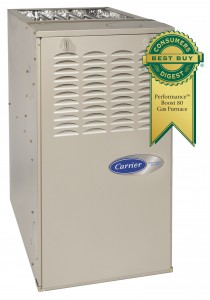Buyer’s Guide to High-Efficiency Furnace Features
Learn about the most important points to consider when shopping for a high-efficiency furnace.
 Did you know that according to the US Department of Energy, about 56 percent of the energy consumed in the average American home goes to heating and cooling? The heating system alone accounts for an average of 30 percent of the total home energy consumption. Naturally, your HVAC system is an excellent place to target when you want to cut your energy consumption, your carbon emissions, and your costs. Here is some helpful information to consider when shopping for a high-efficiency furnace.
Did you know that according to the US Department of Energy, about 56 percent of the energy consumed in the average American home goes to heating and cooling? The heating system alone accounts for an average of 30 percent of the total home energy consumption. Naturally, your HVAC system is an excellent place to target when you want to cut your energy consumption, your carbon emissions, and your costs. Here is some helpful information to consider when shopping for a high-efficiency furnace.
Furnace Size
First and foremost, you must look for a furnace that is correctly sized for your home if you want it to work efficiently. Furnace size should not be based purely on square footage, but must also take into account the energy loss rate in your home. A professional HVAC contractor can analyze your home and tell you what size furnace you need.
Fuel Type
Next, consider the type of fuel you wish to use. While electric furnaces are more efficient than gas ones because they have no flue and hence no potential for energy loss through this opening, the high cost of electricity can easily offset this advantage. If you want electric heat, consider a heat pump.
Furnace Efficiency
Now that you know what size gas furnace you are looking for, start considering specific energy-saving features:
AFUE: All new furnaces being sold today will have an AFUE rating of at least 80. This means that at least 80 percent of the fuel consumed by the furnace is getting turned into heat. According to the DOE, a furnace has to have an AFUE of 90 or higher to be labeled high-efficiency. For mild climates like California, you really don’t need to worry about getting the highest possible AFUE.
Variable Speed Blowers: Furnaces with variable speed blowers are able to save electricity by running at a lower speed and reducing cycling rates. They are also quieter than traditional blowers and provide more even heating.
Electronic Pilot Light: Whereas a standing pilot light is always burning gas, an electronic pilot light only sparks on when it is needed to eliminate waste.
Condensing Furnaces: Condensing gas furnaces capture heat that would otherwise be lost by using heat exchangers to suck heat out of exhaust. The exhaust is then cooled enough to vent out of a PVC pipe through a wall rather than through a flue, which can also save you money on installation costs.
Smart Control Features: Some furnaces come with smart control systems that can interact intelligently with thermostats to optimize efficiency.
Don’t Forget Home & Duct Efficiency
Of course, buying the most efficient furnace on the planet won’t do much good if you connect it to a leaky duct system or a drafty home. Before investing in a new high-efficiency furnace, be sure to schedule a home energy audit from your local HVAC professional to check for leaks.
